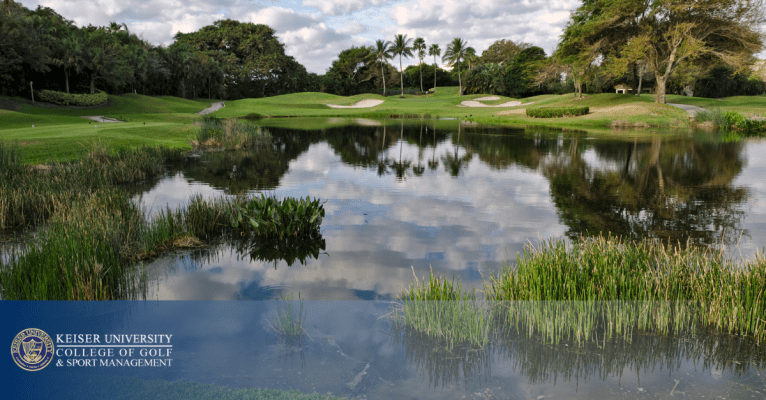How do Golf Courses Prepare for Severe Weather?

The presence of a lush, green turf is essential for the healthy appearance of a golf course. Even in an ideal climate, maintaining consistently vibrant turf can be challenging. Certain environmental conditions – including excessive cold and snow, dryness, heat, humidity, and rainfall – can add to the difficulties courses have in maintaining ideal playing conditions.
How Does Weather Impact a Golf Course?
Obviously, “extreme” weather like hurricanes, tornadoes, and major snow storms can have catastrophic results; however, typical seasonal, regional weather can also lead to prolonged damage to a golf course.
- Hot & Dry Weather: In Arizona, for example, hot and dry weather can cause greens to brown and even die. Dead turf must be replaced by reseeding or re-sodding, which can be very expensive.
- Hot & Humid Weather: In the Southeast (Florida, for example), hot and humid conditions can cause moisture stress, which can cause greens to wilt and can exacerbate the spread of fungal disease, which can take as long as a year to get under control.
- Cold & Frosty Weather: In the Midwest and Northeast (Michigan, for example), greens are subject to “winterkill”, which hinders their growth once conditions are ideal. Additionally, prolonged snow coverage perpetuates a condition called “snow mold.”
Managing and preventing turf distress caused by weather is a constant, collective effort; however, it is entirely possible to keep greens vibrant and healthy even in the most challenging climates.
Golf Course Preparation and Management for Extreme Weather
In order for a golf course to be healthy year-round, teams must make prevention a constant effort. Some of these efforts are relatively easy. For example, shade trees can perpetuate winterkill; by having them pruned, course managers can ensure that adequate sunlight comes through, thus minimizing the amount of turf damaged by winter frost.
Certain preventative measures can be done in any environment to mitigate conditions that typically distress the turf, which include:
- Lack of air flow
- Too much shade caused by vegetation
- Sitting leaves and other debris
- Too much traffic
Other preventative measures are more specific and revolve around the type of weather typical of the golf course’s region.
Preventing the Development of Fungus
Turf maintenance pros know that grass is susceptible to disease and to fungi. Snow and cold are known to cause and perpetuate fungal growth.
To avoid having a fungus problem, preventative measures must be taken well in advance of weather that leads to such conditions.
- Microdorchium Patches: Managers of golf courses subject to cool, wet conditions should take action to prevent Microdochium patches from forming. The patches will be reddish-brown or pink in color and could be surrounded by a dark ring.
- Snow Mold: Snow mold is a fungus that grows (typically) beneath the cover of snow; however, because covers create the same encapsulating conditions as snow, covers can also create snow mold.
- Summer Patch: Also known as Magnaporthe poae, this condition occurs in hot, humid climates.
All types of turf fungus–which spreads easily–should be handled with a fungicidal treatment at least three months prior to the wet and snowy seasons. Fungicidal treatment plans are usually complex and comprehensive.
Preparing for Extremely Cold Conditions
Excessively cold and snowy conditions essentially entomb the turf; as noted, winterkill is always a possibility in environments where prolonged cold and frost are common. Ground covers are an option to assist in protecting areas of a course from winterkill; however, covers are expensive. Further, there is the issue of deciding between permeable and impermeable covers.
- Permeable covers assist in protecting a course from both extreme cold and from dryness; however, if persistent icy conditions result in prolonged frost / ice coverage, then these covers will not be as effective.
- Impermeable covers are more effective at protecting the greens from extensive ice coverage; however, their installation requires them to be tightly tucked into the turf’s surface, which means that no water is able to penetrate (thus leading to excessive dryness and potentially to turf death). Another issue that arises with the use of impermeable covers is that they do not permit much oxygen flow; thus, impermeable covers require regular changing to avoid suffocating the greens.
One note about covers is that they can create the same conditions that cause snow mold, which is why prior treatment for snow mold is of the utmost importance.
Crown Hydration Freeze
Crown hydration freeze is also something that occurs as a result of icy conditions. This threat is most pertinent at the end of the winter season when snow and ice melt. As the temperatures rise and the snow thaws, the ground begins to absorb the liquefied snow.
In many regions where snowfall is common, a few warm days are often followed by another hard freeze, causing the recently absorbed moisture to freeze as well. When this happens, there is the potential for ice crystals to form in the cells of plant life, which will kill the plant. Crown hydration freeze can be mitigated by making drainage pathways in areas with poor drainage, like putting greens; this will help the moisture run off rather than it sitting just below the green’s surface to await another freeze.
Preparing for Extremely Hot Conditions
Heat and humidity are also culprits for causing distress to golf greens. In areas where temperatures get excessively hot during the summer, and conditions are extremely humid, grass can become thin, frail, and brown; in some cases, it can even die. This is typically known as summer turf grass failure.
- Adjust mowing height: While a closely trimmed surface is ideal, grass can be saved from severe weather by raising the mowing height by 1/64 to 1/32nd of an inch.
- Skip a mowing: If greens are already showing distress, mowing can stress them further; skip a mowing to prevent exacerbating the problem.
- Know when to aerate: Soil aeration might seem like a terrible idea when greens are clearly suffering; however, aeration helps dry overly moist soil, and it facilitates oxygen flow back into the root system.
- Be careful when applying chemical treatments: When applied in hot, dry conditions, pesticides and fertilizers can burn and kill the grass.
Having a Comprehensive Management Plan
As previously noted, not all severe weather is predictable – tornadoes, hurricanes, thunderstorms, and blizzards can occur at any time, leaving minimal time to prepare the course for impending distress. This is why course management should have a weather management plan. This plan should define the roles of management and staff, ensuring everyone knows how to react accordingly when severe weather strikes. To prevent being caught off guard, someone’s role should be to monitor the weather via national and local weather information sources, as well as radar. There should be an effective way to systematically advise crew, supervisors, and appropriate personnel when a weather event arises. Sometimes, these individuals work with loud machinery, so an auditory warning / alert system might not be completely effective. Consider incorporating a highly visible flash system that can catch the attention of those who might not be able to hear alarms; these alerts can be lifesaving in case of sudden severe weather like a lightning storm or during a tornado. The most effective way to implement a preventative weather management plan is to have documented, clear-cut management. Action plans for handling seasonal and severe weather should be exercised and discussed on an annual or biannual basis. Additionally, knowledgeable personnel should be available to test soil pH levels, to know when it’s appropriate to apply pesticides, to assess for signs of infection, and to distribute fungicidal treatments. When everyone knows their role and management is well organized and documented, golf courses can prepare for and prevent the ill effects of severe weather conditions.
As a Florida golf school, Keiser University College of Golf enjoys weather golfers love to play in most of the year.
Learn more!
Want more tips? If you want to take your game to the next level, contact our team at Keiser University’s College of Golf & Sport Management today. With our dedication and experience, we can elevate your game to new heights together. Give us a call today at 888-355-4465.















I am a volunteer at a golf course in CO at 8500 ft. We are in a dry period, loss of water supply and use restrictions. Fairways are a rye/blue grass mix and greens are blue/rye mix. What grass species can be recommended for the fairways to minimize water required? What percent of bent grass can be used on greens?
Thank you,
Wally Schrepfer